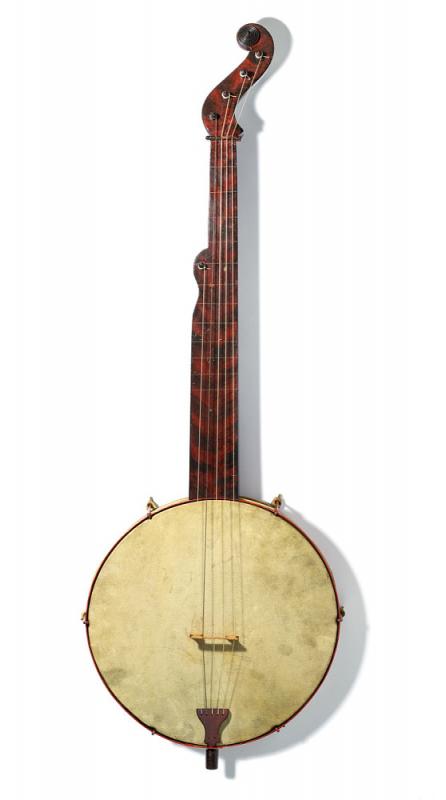Boucher Five-String Fretless Banjo
Musical InstrumentThis banjo was made by William Boucher, Jr. in Baltimore, Maryland in 1845. It is a Five-String Fretless Banjo, with a wood shell with a decorative strip, red painted metal hoops, 6 brackets, and friction pegs. The banjo is stamped:
W.BOUCHER.JR
BALTIMORE
William Boucher was a drum maker and musical instrument dealer in Baltimore, Maryland. He became the first commercial maker of banjos, perhaps through his association with the celebrated minstrel banjoist Joel Walker Sweeney.
His instruments were important in standardizing the form of the banjo in its transition from a homemade rural instrument to urban commercial manufacture. The basic shape and string arrangement has changed little up to the present day. Boucher’s design copied important features of earlier home-made African American instruments: the skin head, short thumb string and fretless neck. He added a scrolled peghead similar to those used by guitar makers W. Stauffer and C. F. Martin, and replaced the traditional gourd body with a thin, bentwood rim construction with screw-tightening brackets similar to that used for drumheads. Boucher’s innovations were well-adapted to commercial mass-production and urban musical tastes and played a large part in the subsequent worldwide enthusiasm for the banjo.
These commercial “improvements” were never adopted by many traditional rural musicians, who continued to make good sounding instruments that were entirely adequate for their musical needs from locally available materials, at little or no expense.
W.BOUCHER.JR
BALTIMORE
William Boucher was a drum maker and musical instrument dealer in Baltimore, Maryland. He became the first commercial maker of banjos, perhaps through his association with the celebrated minstrel banjoist Joel Walker Sweeney.
His instruments were important in standardizing the form of the banjo in its transition from a homemade rural instrument to urban commercial manufacture. The basic shape and string arrangement has changed little up to the present day. Boucher’s design copied important features of earlier home-made African American instruments: the skin head, short thumb string and fretless neck. He added a scrolled peghead similar to those used by guitar makers W. Stauffer and C. F. Martin, and replaced the traditional gourd body with a thin, bentwood rim construction with screw-tightening brackets similar to that used for drumheads. Boucher’s innovations were well-adapted to commercial mass-production and urban musical tastes and played a large part in the subsequent worldwide enthusiasm for the banjo.
These commercial “improvements” were never adopted by many traditional rural musicians, who continued to make good sounding instruments that were entirely adequate for their musical needs from locally available materials, at little or no expense.
